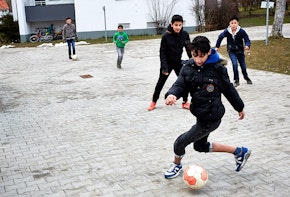Youth unemployment and youth disconnection have reached historic numbers in the past decade, with little relief in sight. According to Measure of America, 5.5 million young Americans aged 16–24 are neither working, nor in school.1 The crisis has reached national attention, spurring campaigns such as the bipartisan Opportunity Nation, a coalition comprised of more than 300 businesses, nonprofits, and organizations. Most recently, 2016 presidential candidate Hillary Clinton called for a push to increase the availability of apprenticeships in order to help tackle youth unemployment.
However, one solution, which could potentially amount to an additional one million summer jobs for youth over the next ten years, has been largely neglected. Every year, anywhere from 80,000 to 150,000 summer jobs are delegated to foreign university students who are visiting on the Summer Work Travel (SWT) category of the J-1 Visa Exchange Visitor Program.
Over the past few decades, the J-1 visa, which is primarily supposed to function as a cultural exchange program, has been repeatedly criticized for its lax regulations and poor structure. Two reports, one by the Economic Policy Institute (EPI) and the other by the Southern Poverty Law Center (SPLC), have documented the many problems with the SWT program, revealing participants that have been exposed to harsh working and living conditions, below minimum wages, and, at the extreme, human trafficking and illicit money transfer schemes.2 The program, which has become mainly a cheap labor program, also lacks protection for domestic workers who may be displaced or negatively affected by J-1 visa participants, due in part to the fact that it falls under the Department of State, rather than the more appropriate Department of Labor.
Abolishing the SWT category of the J-1 visa could free up potentially 109,000 jobs annually for young Americans at a time when they are desperately needed. In the summer of 2014, around 1.1 million youth aged 16 to 19 were looking for jobs but could not find them—10 percent of which could have filled SWT jobs.3 With this in mind, the following brief will (1) evaluate the effectiveness of J-1 visa in providing a positive cultural experience for its participants, and (2) where the J-1 visa program fails in this regard, examine how eliminating the program would open up opportunities to unemployed American youth.
Overview of the J-1 visa Program
In 1961, during the Cold War, Congress enacted the Mutual Educational and Cultural Exchange Act (also known as the Fulbright-Hays Act), which authorized and created the J-1 Visa Exchange Visitor Program. The purpose of the J-1 visa is to facilitate educational and cultural exchange between the United States and other countries. Still ongoing, the J-1 visa is now our country’s largest guest worker program in terms of new annual entries. In 2010, the program brought in 350,000 exchange visitors (including their spouses and dependents) to work and study.4
The J-1 visa is separated into fourteen categories: Au Pair, Camp Counselor, College and University Student, Government Visitor, Intern, International Visitor, Physician, Professor and Research Scholar, Secondary School Student, Short-Term Scholar, Specialist, Summer Work Travel, Teacher, and Trainee.5 While many of the J-1 visa categories function as they were originally intended—to facilitate meaningful exchanges—some employers have taken advantage of the program in order to import and exploit young foreign workers.
The J-1 visa is structured so that the Department of State outsources much of the implementation and regulation to designated sponsors. These sponsors are the crux of the program—they are the ones who connect J-1 visa applicants to employers, and they collect a fee for doing so. Their responsibilities include vetting employers, making sure the cultural component of the program is fulfilled, ensuring the welfare of participants, and maintaining participants’ records in the Student and Exchange Visitor Information System (SEVIS).
The J-1 visa is a private sector exchange program and is primarily funded through participant and sponsor fees. For example, as seen in Figure 1, participants pay a fee to a sponsor (and in some cases, overseas agents) as well as visa application fees to the Department of State. The average J-1 sponsor fee ranges from $400 to $2,000, and officials estimate that total participant fees, excluding airfare, range from $1,500 to $5,000.6Sponsors must also pay a designation fee (initially and every following two years) of $2,700 to the Department of State.
Summer Work Travel
Of the fourteen J-1 visa categories, Summer Work Travel7is by far the largest and the most problematic. In 2010, there were 307,369 total J-1 visas issued (not counting J-2 visas for spouses and dependents), and more than a third, 132,342, were SWT participants.8 In comparison, the second largest category, college and university student, had 40,492 participants. In 2009 the SWT category peaked with 152,726 participants, but in 2011, the Department of State implemented a cap of 109,000 participants. In 2014, there were approximately 79,000 SWT participants.
SWT brings in university students during their summer breaks to work mainly at seasonal businesses, such as hotels, restaurants, and beach resorts. The Code of Federal Regulations states that “the purpose of [the SWT program] is to provide foreign college and university students with opportunities to interact with U.S. citizens, experience U.S. culture while sharing their own cultures with Americans they meet, travel in the United States, and work in jobs that require minimal training and are seasonal or temporary in order to earn funds to help defray a portion of their expenses.”9 Participants are allowed to stay in the United States for up to four months and must be enrolled in a postsecondary institution. They typically work in seasonal jobs such as at hotels, summer resorts, restaurants, and amusement parks.
Problems with the J-1 Visa and Summer Work Travel
Despite its popularity, the Summer Work Travel program and the J-1 visa as a whole suffer from serious problems that undermine the visa’s mission and worth. These problems include poor oversight and program design, as well as the existence of perverse incentives.
Little Governmental Oversight of Employers and Sponsors
Under the current structure, the Department of State relies on sponsors to monitor the program and thus has little contact or relationship with employers themselves, which inherently leads to lack of oversight and accountability. In 2009, there were only thirteen Department of State compliance officers who were responsible for monitoring the welfare of almost 350,000 participants and 3,000 sponsors.10 The most severe sanction at their disposal is to revoke a sponsor’s designation. SPLC’s study reveals that even when participants report employer or sponsor violations directly to the Department of State, such as through the department hotline, they often receive little and/or inadequate response.
Employer Incentives to Hire J-1 Visa Participants
There are many reasons why employers would prefer J-1 visa applicants over domestic workers, although most of them boil down to cost-savings. A 1990 Government Accountability Office report states that employers prefer to use the J-1 visa because the requirements were not as stringent as other visas (some which require labor certifications).11The report attributes the large increase of J-1 visa admissions in the 1980s to this employer preference. Here are some reasons why employers find the J-1 visa program so attractive:
- Tax Savings: Employers are often exempt from paying certain taxes for their J-1 employees, such as Medicare, Social Security, and federal and state unemployment taxes. Additionally, employers are not required to pay any health care costs because visitors are required to have their own coverage for the duration of their stay (which can result in up to $1,500 in savings per worker).12
- Lax Wage Regulations: The rule on participant compensation states that sponsors must ensure that participants are paid the higher of either the applicable minimum wage or pay commensurate with that offered to their similarly situated U.S. counterparts. However, sponsors are not given any guidance as to how to go about doing so—for example, there is no requirement that they cooperate with the Department of Labor to certify local prevailing wages, thus making such enforcement unlikely.13
- Using Housing to Cut Wages: There have been cases of employers placing participants in employee-sponsored housing, but charging much higher than market rate.14After this is accounted for, participants often end up making less than minimum wage after taking out the rent owed to their employers. Unfortunately, due to desperation and lack of protection, participants are vulnerable and often encounter situations where they will accept any wage and working condition.
Department of State Response Is Lackluster
In 2011 and 2012, the Department of State introduced new regulations to address some of the problems that policymakers and reporters have been concerned about for decades.15Amendments to the SWT regulation include requiring participants from certain countries to have prearranged jobs, eliminating certain job categories (such as dangerous and difficult jobs in agriculture and construction as well as graveyard shifts), and capping the program at 109,000 participants. The new regulations also require sponsors to vet employers and overseas agents, provide a list of itemized participant fees, and ensure fulfillment of the cultural component of the program. Sponsors must also inform participants of the federal minimum wage, ensure they are compensated similarly to their American counterparts, and prevent employers from making a profit from providing employer-sponsored housing.
Perhaps the greatest criticism of these new regulations is that they do nothing to address the fact that sponsors are entirely responsible for ensuring employer compliance. Sponsors are basically business partners with the employers they serve, thus they do not have the appropriate distance or the authority necessary for proper oversight.
Unsurprisingly, the Department of State has had difficulties enforcing some of these new regulations. For example, they explicitly state that it is the responsibility of sponsors to make sure that the cultural element of the SWT program is fulfilled. However, according to a 2015 Government Accountability Office report, only 60 percent of participants indicated that they participated in cultural activities.16The new regulations also require sponsors to annually submit price lists itemizing fees that they charge their participants, but the report made clear that the Department of State has not yet established mechanisms to enforce this requirement. Consequentially, the department is unable to protect program participants from excessive or exploitative fees.
Case Examples of Employer and Sponsor Abuse
Although 90 percent of the 2,505 participants interviewed by the Department of State in 2014 stated they were satisfied with the program experience, the Government Accountability Office report rightly notes: “If even one participant has a harmful or abusive experience, the potential also exists for notoriety and disrepute to the program, State, and the country.” Multiple reports indicate that while abuse of the program may not be as extensive as it used to be, there are certainly severe cases that are widespread enough to be extremely detrimental to the welfare of participants.
- SPLC details many examples of participants paying large fees ($3,000 to $4,000) to work as housekeepers in hotels, without being allowed time for any of the promised cultural activities. Many had rent deducted from their paychecks, often at twice the market price, for living with other J-1 participants in overcrowded apartments (two workers interviewed were forced to sleep in horse stables). Many left the program in debt, due to the fact that they were not paid enough to cover costs or because they were victims of predatory lending by overseas recruiters.17
- An Associated Press investigation in 2010 revealed that some students only made $1 per hour or less after recruiters deducted pay for fees and fines. Some students were forced by their employers to work at strip clubs, rather than wait tables as promised. Most had to acquiesce in order to pay back the program fees.18
- In 2011, J-1 visa participants paid fees as much as $3,000 to $6,000 to work at a Hershey distribution center in Pennsylvania. After housing deductions, they earned only $40 to $140 per week for forty-hour weeks. Almost four hundred students staged a walkout and filed a lawsuit. In 2012 they won $200,000 in back wages from the Department of Labor.19
- In 2013, J-1 visa participants paid up to $4,000 to work at a McDonald’s in Pennsylvania. Their contract specified that they would get forty hours of work per week, but they only got twenty-five hours. The participants had to pay the franchise owner $300 per month to live in a basement shared with seven others. One of the students, Jorge Rios, organized a protest and a strike.20
How Eliminating SWT Could Benefit Disconnected Youth
Between 2000 and 2010, employers hired over one million foreign youth from the SWT program. As we’ve seen, there is a strong case for eliminating the SWT category of the J-1 visa, in order to protect its participants from excessive fees and employer abuse. However, there is an equally strong case to be made that American youth also have the potential to benefit from the hundreds of thousands of jobs that would be freed up. Of course, 80,000 to 150,000 summer jobs every year is by no means a silver bullet for the greater issue of youth unemployment. However, these jobs, which have proven to have limited cultural value and have even harmed relations with foreign youth, could be much more beneficial to the young and unemployed in America.
While the economy has recovered over the past few years, and unemployment has fallen overall, our country still has a historically high youth unemployment rate. During the Great Recession, youth unemployment (those aged 16 to 24) increased from 10.6 to 19.5 percent, and it is currently at 13 percent, which is more than double the national average. As the Working Paper Series by my colleague Mike Cassidy notes, a worker aged 16 to 24 years is 53 percent more likely to be unemployed than one who is aged 35 to 54 years.21
During the start of summer, the youth labor force, defined as those actively looking for work, grows sharply. In 2014, the summer labor force grew by 3 million youth. Although there are also more jobs available for youth in the summer, youth unemployment was roughly the same, at 14.3 percent. Unemployment for black and Hispanic youth was especially pronounced, at 24.8 and 16.5 percent, respectively. 22
Unsurprisingly, American youth work in the same summer industries that J-1 visa participants do, with hospitality and retail employing the highest numbers of young workers.23Accordingly, the youth demographic has the most potential to be negatively affected by an influx of SWT workers. However, the J-1 visa program lacks careful consideration of the potential labor market effects of bringing in thousands of young workers each year. Officials place the entire burden of responsibility on sponsors, rather than directly enforcing employers to ensure that American workers are not displaced. Employers are not even required to advertise their jobs domestically. Additionally, the Department of State offers no protection or recourse for American workers who are negatively impacted by the SWT program.
In 2012, ten states commanded the majority of SWT participants, with the five top states being New York, New Jersey, Maryland, Massachusetts, and Florida (see Figure 2). Of those states, three (New York, New Jersey, and Florida) had significantly high youth unemployment rates (18, 18.2, 16.4 percent, respectively; see Figure 3).24California, and which had the eighth-largest amount of SWT participants, had a youth unemployment rate of 20.2 percent.
These states also are home to metropolitan areas that are struggling with youth disconnection (youth who are neither working nor in school). For example, Lakeland-Winter Haven, FL ranked in the bottom three in terms of youth disconnection in an evaluation of the country’s 98 most populous metropolitan areas.25In absolute numbers, New York City had the greatest amount (324,264) of disconnected youth. New York is also home to the second-worst congressional district among those surveyed: District 15 in the South Bronx, which has a 24.2 percent rate of youth disconnection.


Policy Proposals
With its history of labor abuses and a potential 109,000 summer jobs on the line every year, policymakers should look at the possibility of reallocating J-1 visa SWT resources to the unemployed youth of America. Other J-1 visa categories that have proven to have cultural value, such as students and researchers, could be expanded in order to offer more opportunities for foreign youth. Meanwhile, state and local Workforce Investment Boards (WIBs) could work with employers and businesses that normally employ summer J-1 visa participants and connect them with unemployed youth in nearby localities. This should be a priority for states with the largest number of SWT participants.
WIBs should also keep in mind the unique challenges facing disconnected youth, such as connecting them with subsidized child care (one out of three disconnected females are mothers) and securing adequate transportation. Additionally, although American youth are less vulnerable to abuse than foreign youth, since they do not depend on their employers to stay in the country, officials should still ensure that employers are thoroughly vetted in order to protect the young employees.
At the very least, the Department of State should do more to directly oversee that the presence of SWT participants are not negatively impacting unemployed youth, rather than outsourcing this responsibility to sponsors. The Department of State should also sponsor more research on the impact of J-1 visa guest workers. The Economic Policy Institute has also suggested capping the number of SWT participants every year inversely to the youth unemployment rate.26
Over one million youth in the last ten years have been subject to an exchange program that continues to fail on its most important tenet–ensuring a safe and culturally enriching experience for its participants. This same decade has been a lost one for our country’s own young adults. It’s time for officials to revisit the J-1 visa program and make sure it is working for the youth involved, both at home and abroad.
Notes
-
1. Kirsten Lewis and Sarah Burd-Sharps, “Zeroing In on Place and Race,” Measure of America, June 2015, http://ssrc-static.s3.amazonaws.com/wp-content/uploads/2015/06/MOA-Zeroing-In-on-Place-and-Race-Final.pdf.
2. Daniel Costa, “Guestworker Diplomacy,” Economic Policy Institute, July 14, 2011, http://s4.epi.org/files/2011/BriefingPaper317.pdf; Meredith B. Stewart, “Culture Shock,” Southern Poverty Law Center, February 2, 2014, http://www.splcenter.org/sites/default/files/downloads/publication/j-1_report_v2_web.pdf.
3. U.S. Department of Labor, Bureau of Labor Statistics, Current Population Survey, http://www.bls.gov/cps/demographics.htm, retrieved July 7, 2015.
4. Costa, “Guestworker Diplomacy.
5. U.S. Department of State, Bureau of Educational and Cultural Affairs, J-1 Visa website, http://j1visa.state.gov/, retrieved June 17, 2015.
6. Government Accountability Office, (2015). Summer Work Travel Program. (GAO Publication No. 15-265). Washington, D.C.: U.S. Government Printing Office.
7. Other categories, such as Trainee and Au Pair, are known to have similar problems, but this report will focus on Summer Work Travel since it is the largest category.
8. Costa, “Guestworker Diplomacy.”
9. Exchange Visitor Program, 22 C.F.R. § 62.32 (2012).
10. Costa, “Guestworker Diplomacy.”
11. Government Accountability Office, Inappropriate Uses of Educational and Cultural Exchange Visas, GAO publication no. 90-61 (Washington, D.C.: U.S. Government Printing Office, 1990).
12. Costa, “Guestworker Diplomacy.”
13. Ibid.
14. Meredith B. Stewart, “Culture Shock,” Southern Poverty Law Center, February 2, 2014, http://www.splcenter.org/sites/default/files/downloads/publication/j-1_report_v2_web.pdf.
15. Exchange Visitor Program—Summer Work Travel, 22 C.F.R. Part 62 (2011), http://j1visa.state.gov/wp-content/uploads/2012/09/dos_frdoc_0001-1491-1-.pdf; Exchange Visitor Program—Summer Work Travel, 22 C.F.R. Part 62 (2012), http://j1visa.state.gov/wp-content/uploads/2012/05/2012-swt-ifr.pdf.
16. Government Accountability Office, (2015). Summer Work Travel Program.
17. Stewart, “Culture Shock.”
18. “J-1 visa: Cultural exchange program under scrutiny,” Associated Press, June 17, 2011, http://hosted.ap.org/specials/interactives/_national/j1-visa/.
19. Julia Preston, “Foreign Students in Work Visa Program Stage Walkout at Plant,” New York Times, August 17, 2011, http://www.nytimes.com/2011/08/18/us/18immig.html?_r=1.
20. Yuki Noguchi, “U.S. Probes Abuse Allegations under Worker Visa Program,” NPR, March 18, 2013, http://www.npr.org/2013/03/18/174410945/u-s-probes-abuse-allegations-under-worker-visa-program.
21. Mike Cassidy, “Working Paper Series: A Detailed Look at the Labor Market Recovery,” The Century Foundation, December 11, 2014, http://apps.tcf.org/who-are-the-unemployed.
22. “Employment and Unemployment among Youth Summary,” Bureau of Labor Statistics, August 13, 2014, http://www.bls.gov/news.release/youth.nr0.htm.
23. “Youth employment in summer 2012,” Bureau of Labor Statistics, August 22, 2012, http://www.bls.gov/opub/ted/2012/ted_20120822.htm.
24. “Employment status of the civilian noninstitutionalized population in states by sex, race, Hispanic or Latino ethnicity, marital status, and detailed age,” Bureau of Labor Local Area Unemployment Statistics, 2012, http://www.bls.gov/lau/table14full12.pdf.
25. Lewis and Burd-Sharps, “Zeroing In on Place and Race.”
26. Daniel Costa and Ross Eisenbrey, “EPI public comments on State Department’s changes to J-1 visa Summer Work Travel program,” July 10, 2012, http://www.epi.org/publication/public-comments-state-department-j-1-swt-program-july-2012/.











